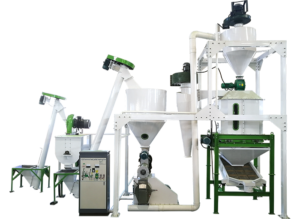
The sales revenue of a 50 tons per hour (t/h) feed mill engineering project is a critical metric for assessing the financial viability and success of the operation. However, market demand fluctuations can significantly impact this calculation. Understanding how these changes affect sales revenue is essential for feed mill operators, investors, and stakeholders. This article explores the various ways market demand changes can influence the sales revenue of a 50t/h feed mill engineering project.
Understanding the Basics: Production Capacity and Potential Revenue
First, let’s establish the theoretical production capacity and potential revenue of a 50t/h feed mill:
- Hourly Capacity: 50 tons
- Daily Capacity: Assuming the mill operates 16 hours a day, the daily capacity is:50 tons hour×16 hours day=800 tons day50tons hour×16hours day=800tons day
- Annual Capacity: Assuming the mill operates 300 days a year, the annual capacity is:800 tons day×300 days year=240,000 tons year800tons day×300days year=240,000tons year
Assuming an average selling price of $300 per ton, the potential annual sales revenue is:
240,000 tons year×$300/ton=$72,000,000240,000tons year×$300/ton=$72,000,000However, this calculation assumes constant market demand, which is rarely the case. Market demand fluctuations can significantly impact actual sales revenue.
Factors Influencing Market Demand
Several factors can cause market demand to fluctuate, impacting the sales revenue of a feed mill:
- Seasonal Variations
- Demand for animal feed often varies seasonally. For example, demand may increase during certain agricultural cycles or decrease during off-seasons.
- Impact: Seasonal demand fluctuations can lead to periods of high sales and revenue, followed by periods of reduced sales.
- Economic Conditions
- Economic downturns or booms can affect livestock farming activities, influencing feed demand.
- Impact: During economic downturns, farmers may reduce livestock numbers, decreasing feed demand. Conversely, economic growth can boost demand.
- Feed Prices and Raw Material Costs
- Changes in feed prices and the cost of raw materials (e.g., corn, soybeans) can affect demand.
- Impact: Higher feed prices may reduce demand, while lower prices can stimulate it. Similarly, fluctuations in raw material costs can affect production costs and pricing strategies.
- Livestock Population Trends
- Changes in livestock populations, driven by disease outbreaks, government policies, or market trends, can influence feed demand.
- Impact: An increase in livestock populations boosts feed demand, while a decrease has the opposite effect.
- Competition
- The presence and actions of competitors in the market can affect demand for a particular feed mill’s products.
- Impact: Increased competition may lead to price wars, reducing revenue. Conversely, a strong market position can help maintain demand and pricing power.
- Government Policies and Regulations
- Policies related to agriculture, trade, and environmental regulations can impact feed demand.
- Impact: Subsidies for livestock farming can increase feed demand, while restrictive regulations may reduce it.
- Technological Advancements
- Innovations in feed production and livestock farming can change demand patterns.
- Impact: New feed formulations or farming techniques can create new demand or render existing products obsolete.
Related post: https://www.richipelletmachine.com/feed-mill-factory/
Calculating Sales Revenue with Market Demand Fluctuations
To account for market demand fluctuations, it’s essential to use a more dynamic approach to sales revenue calculation. Here are some steps to consider:
- Scenario Analysis
- Develop multiple scenarios based on different market demand conditions (e.g., high, medium, low demand).
- Calculate potential sales revenue for each scenario.
Example:
- High Demand Scenario: 90% capacity utilization, average price $310/ton240,000 tons year×0.90×$310/ton=$66,960,000240,000tons year×0.90×$310/ton=$66,960,000
- Medium Demand Scenario: 80% capacity utilization, average price $300/ton240,000 tons year×0.80×$300/ton=$57,600,000240,000tons year×0.80×$300/ton=$57,600,000
- Low Demand Scenario: 70% capacity utilization, average price $290/ton240,000 tons year×0.70×$290/ton=$48,720,000240,000tons year×0.70×$290/ton=$48,720,000
- Sensitivity Analysis
- Assess how sensitive the sales revenue is to changes in key variables such as feed prices, raw material costs, and capacity utilization.
- Identify the most critical factors that impact revenue and focus on managing these effectively.
- Market Research and Forecasting
- Conduct regular market research to stay informed about demand trends, competitor actions, and economic conditions.
- Use forecasting models to predict future demand and adjust production and pricing strategies accordingly.
- Diversification
- Diversify the product mix to cater to different market segments and reduce dependency on a single product type.
- Explore new markets, including export opportunities, to spread risk.
- Flexible Production Planning
- Implement flexible production planning to adjust output based on real-time demand data.
- Use inventory management techniques to balance production and storage costs with market demand.
Mitigating the Impact of Market Demand Fluctuations
To mitigate the impact of market demand fluctuations on sales revenue, consider the following strategies:
- Long-Term Contracts
- Secure long-term contracts with key customers to ensure stable demand and revenue.
- Negotiate flexible terms that allow for price adjustments based on market conditions.
- Value-Added Services
- Offer value-added services such as nutritional consulting, custom feed formulations, and technical support to differentiate from competitors and build customer loyalty.
- Cost Management
- Implement cost management practices to maintain profitability even during periods of low demand.
- Focus on reducing production costs, optimizing supply chains, and improving operational efficiency.
- Marketing and Branding
- Invest in marketing and branding to build a strong market presence and attract new customers.
- Highlight the quality, consistency, and benefits of the feed products to justify premium pricing.
- Innovation and R&D
- Invest in research and development to create innovative feed products that meet evolving market needs.
- Stay ahead of industry trends and continuously improve product offerings.
Conclusion
The sales revenue calculation for a 50t/h feed mill engineering project is significantly influenced by market demand changes. By understanding and accounting for these fluctuations, feed mill operators can develop more accurate revenue projections and implement strategies to mitigate risks. Scenario analysis, sensitivity analysis, market research, diversification, and flexible production planning are essential tools for managing the impact of market demand changes on sales revenue. By adopting these strategies, feed mill operators can ensure the long-term success and profitability of their operations, even in the face of market uncertainties.
For details please contact: pellet mill for sale
WhatsApp:86 138 3838 9622
Email:enquiry@richipelletmachine.com






